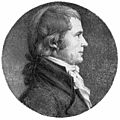Marbury v. Madison facts for kids
Marbury v. Madison was a very important court case in the United States Supreme Court in 1803. It was a disagreement between William Marbury and James Madison. This case helped define the power of the Supreme Court. It established something called judicial review. This means the Supreme Court can decide if a law follows the United States Constitution.
Contents
Understanding Marbury v. Madison
What Happened Before the Case?
In the year 1800, there was a big election for President of the United States. Thomas Jefferson won the election, beating John Adams. Before Adams left office, he wanted to give jobs to many people. This way, Jefferson could not choose his own people for these jobs.
The United States Senate agreed with Adams' choices. John Marshall, who was Adams' Secretary of State at the time, was supposed to send out the official papers for these new jobs. Marshall was also going to become the Chief Justice of the United States soon.
Many of these job notices were sent out. But one notice, for a man named William Marbury, did not get delivered before Adams' last day in office. Marbury was supposed to become a Justice of the Peace in Washington, D.C..
Why Did Marbury Sue Madison?
When Thomas Jefferson became President, he told his own Secretary of State, James Madison, to stop delivering any job notices that had not been sent yet. This meant William Marbury did not get his job.
So, William Marbury decided to sue James Madison. Marbury wanted the court to force Madison to give him the job he believed he was promised.
The Supreme Court's Decision
How Chief Justice Marshall Ruled
John Marshall was the Chief Justice of the Supreme Court when this case happened. He had to make the final decision.
First, Marshall said that William Marbury had a right to his job. He explained that the job was official once it was signed and approved. The actual delivery of the paper was just a custom, not a strict rule.
Next, Marshall said that a special court order called a writ of mandamus was the right way for Marbury to ask for his job. This type of order tells a government official to do something.
Finally, Marshall looked at a law called the Judiciary Act of 1789. This law seemed to allow the Supreme Court to issue this kind of order.
The Big Question: Who Decides?
The most important question was who had the power to make this decision. Chief Justice Marshall said that the Supreme Court could decide. He noted that the Judiciary Act of 1789 gave the Supreme Court this power.
However, Marshall then said something very important. He ruled that a part of the Judiciary Act of 1789 was actually against the United States Constitution. This part of the law allowed the Supreme Court to issue a writ of mandamus in cases like Marbury's. But the Constitution itself did not give the Supreme Court that specific power.
Because the Constitution is the highest law, Marshall declared that the part of the Judiciary Act was unconstitutional. This meant the Supreme Court could not issue the writ for Marbury. So, Marbury did not get his job through this lawsuit.
What is Judicial Review?
Chief Justice Marshall's decision to look at both the Constitution and the law (the Judiciary Act) was a huge moment. This act of deciding if a law follows the Constitution is called judicial review.
This case established that the Supreme Court has the independent power to decide if any law or government action is constitutional or not. This power makes the Supreme Court a very important part of the United States government.
Images for kids
-
An 1808 engraving of Chief Justice John Marshall by French portrait painter Charles Balthazar Julien Févret de Saint-Mémin
-
The U.S. Capitol, home of the U.S. Congress and also where the U.S. Supreme Court convened from 1801 until the Supreme Court Building's completion in 1935.
-
Marshall's famous line from Marbury v. Madison on American federal courts' power to interpret the law, now inscribed on the wall of the U.S. Supreme Court Building in Washington, D.C.
-
The subpoena duces tecum (order to bring items as evidence) issued to President Richard Nixon that was the center of the dispute in the 1974 judicial review case United States v. Nixon
See also
 In Spanish: Caso Marbury contra Madison para niños
In Spanish: Caso Marbury contra Madison para niños





